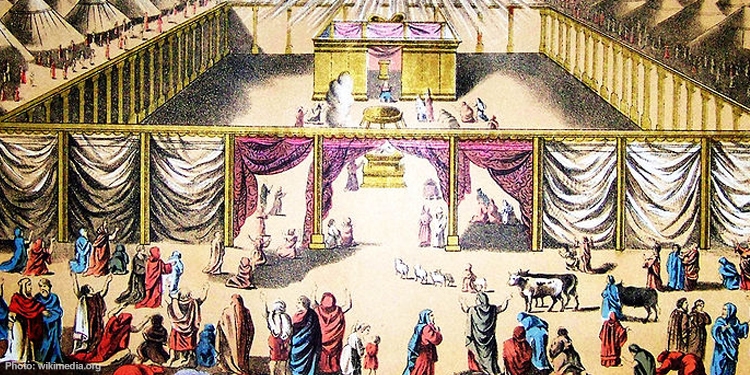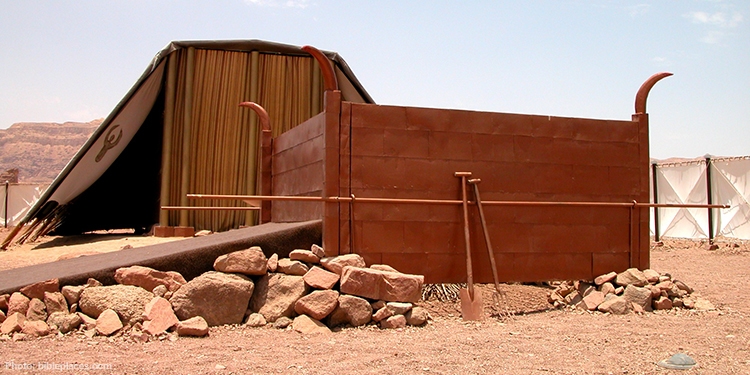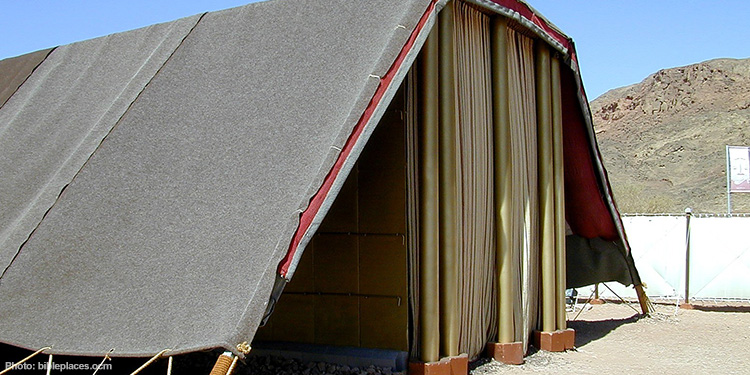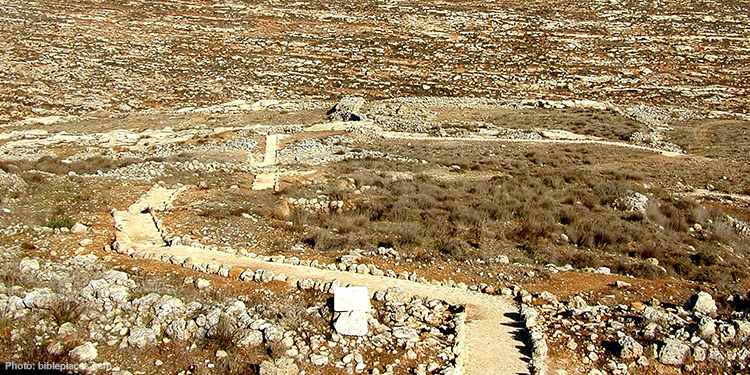What Is the Tabernacle?

While people of all religions are accustomed to connecting with God at houses of worship today, this was not always the case. Long before the Jewish people prayed in synagogues, God communicated with them in all sorts of unusual places. He appeared to Abraham in visions, wrestled with Jacob, spoke to Moses from a burning bush, and led the Israelites through the desert with pillars of cloud and fire. However, the book of Exodus describes how God commanded Moses to construct a special place for Him to dwell among His people–the Tabernacle.
The Tabernacle was a portable sanctuary that served as the central place of worship for the nation of Israel throughout their wandering in the desert and after their entrance into the Promised Land. It was considered to be the place where God’s divine presence dwelled among the Israelites — the intersection of divine and earthly realms.
The Tabernacle served as the primary place of worship for the Israelites until the Holy Temple was built in Jerusalem by King Solomon.
What Does Tabernacle Mean?
In the Bible, the Tabernacle is referred to as the mishkan, which literally translates to “residence” or “dwelling place.” Mishkan comes from the Hebrew root “to dwell,” and so the Tabernacle was the earthly dwelling place where God manifested His presence and communicated His will. It is also referred to as the ohel moed, the Tent of Meeting.
What Was Its Purpose?

These names give us insight into the purpose of this structure – a sacred space for God to manifest His divine presence on earth and draw closer to His people. After the Israelites left Egypt, they wandered through the desert wilderness for many years on their journey to the Promised Land. God commanded them to construct a temporary place of worship—a symbolic home for Him on earth—that they could take with them as they moved from place to place. Even as they wandered, the Israelites knew that God was with them.
The Israelites served God in the Tabernacle through sacrifices of animals, incense, and showbread. Within the Tabernacle, the priests lit the seven-branched menorah daily, symbolically bringing Divine light into this sacred space. The Tabernacle also played a central role in religious festivals, including the Day of Atonement (Yom Kippur), Passover, Shavuot (Pentecost), and the Feast of Tabernacles, also known as Sukkot. Furthermore, the Tabernacle was a communal gathering place where leaders would convene and the people would come for guidance.
The Tabernacle in the Bible
In perhaps the most important verse about the Tabernacle, God commands Moses to lead the people in building a structure for Him: “Then have them make a sanctuary for me, and I will dwell among them” (Exodus 25:8). Grammatically, one would expect this verse to read, “and I will dwell in it,” because the Tabernacle was a singular structure. Considering God is incorporeal, the Jewish sages explain the plural language by suggesting that the Tabernacle served as a physical reminder for each individual to create a place for God within their hearts. When we build sacred structures, create holy communities, and live righteous lives, we make a space that is worthy of God’s presence.
Beyond this verse, the main biblical sources describing the Tabernacle are found in the book of Exodus. Chapters 25-31 record God’s detailed instructions for how the Tabernacle should be built, including the materials and dimensions. Chapters 35-40 are largely a repetition of these instructions in past tense, describing their execution. Within these technical details, there are also verses that give insight into the spiritual power of the Tabernacle:
“There I will meet you and speak to you; there also I will meet with the Israelites, and the place will be consecrated by my glory. So I will consecrate the tent of meeting and the altar and will consecrate Aaron and his sons to serve me as priests. Then I will dwell among the Israelites and be their God. They will know that I am the LORD their God, who brought them out of Egypt so that I might dwell among them. I am the L their God.”—Exodus 29:42-46
Who Built The Tabernacle?
The construction of the Tabernacle was overseen by Moses, who received direct commandments from God. However, the project was a collaborative effort of the entire nation. According to Exodus 35:20-29, the materials were donated by the Israelites. As it says in verse 21, “and everyone who was willing and whose heart moved them came and brought an offering to the LORD for the work on the tent of meeting, for all its service, and for the sacred garments.” In fact, the people gave with such enthusiasm that Moses had to instruct them to stop. (See Exodus 36:3-7).
Each individual offered their unique abilities to this project. According to chapter 35 verse 25, “Every skilled woman spun with her hands and brought what she had spun.” Beyond the materials, there were specific individuals selected by God to play a key role in the actual construction, such as Bezalel and Oholiab:
Then the LORD said to Moses, “See, I have chosen Bezalel son of Uri, the son of Hur, of the tribe of Judah, and I have filled him with the Spirit of God, with wisdom, with understanding, with knowledge and with all kinds of skills— to make artistic designs for work in gold, silver and bronze, to cut and set stones, to work in wood, and to engage in all kinds of crafts. Moreover, I have appointed Oholiab son of Ahisamak, of the tribe of Dan, to help him.”—Exodus 31:1-6
There were many skilled artisans that joined in the complex project, all instructed to use their God-given gifts to serve this higher purpose (Exodus 36:1). These verses paint a beautiful picture of what it looks like when people come together to serve God, each using their unique skills to give what they can with joy. When the construction was complete, Moses gave it his stamp of approval and the presence of God immediately came to dwell in the Tabernacle: “Then the cloud covered the tent of meeting, and the glory of the Lord filled the tabernacle.” (Exodus 40:34)
What Did It Look Like?

The Tabernacle consisted of a portable tent and a wooden enclosure draped with indigo, purple, and scarlet curtains. The complex was surrounded by a rectangular fence made of fabric and poles. In the courtyard between the fence and the Tabernacle, there was a bronze altar for sacrificial offerings and a bronze water basin for the priests to wash.
Its dimensions were 30 cubits long by 10 cubits wide and 10 cubits high, a cubit being an ancient measure that is approximately equal to 18 inches. That would translate into a structure that was about 45 feet long by 15 feet wide and 15 feet high.
The tent itself had two rooms separated by a goat-hair curtain. The Holy Place contained the altar of incense on the west, the seven-branched menorah on the south, and the table for the showbread on the north. The Holy of Holies was a square-shaped inner room which housed the Ark of the Covenant, a gold-covered wooden box with two golden cherubs on top. Inside the Ark were the tablets of the Ten Commandments that Moses brought down from Mount Sinai.
How Was the Tent of Meeting Moved?
Throughout the Israelites’ time in the desert, God communicated when it was time to travel through the Tabernacle:
In all the travels of the Israelites, whenever the cloud lifted from above the tabernacle, they would set out; but if the cloud did not lift, they did not set out—until the day it lifted. So the cloud of the Lord was over the tabernacle by day, and fire was in the cloud by night, in the sight of all the Israelites during all their travels.—Exodus 40:36-38
They dismantled, transported, and re-erected the Tabernacle in each place they camped, according to the detailed instructions laid out in the Bible. It was the job of the priests to prepare the Tabernacle, including protecting the sacred objects with special coverings, for transport. Groups of Levites were assigned different duties, such as the Kohathites who carried the most sacred items using special poles, as it was forbidden to touch them directly (Numbers 4:1-20). According to 2 Samuel 6:7, anyone who touched the Ark of the Covenant would die instantly.
History of the Tabernacle’s Locations

While the Bible does not always explicitly mention whether or not the Tabernacle was erected in each camp, the sages assume that it usually was, especially in key places, such as Succoth, Etham, Pi Hahiroth, Marah, Elim, Rephidim, and other sites in the Israelites’ journey in the desert that are mentioned in Numbers 33:16-37.
The most significant camp was Mount Sinai, where the Israelites received the Ten Commandments while the Tabernacle was set up at the base of the mountain. Another important place was Kadesh-barnea, where the Israelites received the report from the twelve spies and camped for many years.
After they entered the land of Canaan, the Tabernacle was set up in Gilgal. After the division of the land among the twelve tribes, it was moved to Shiloh, where it remained for the 300-year period of the Judges. At certain times, it was also set up in Bethel, where it served as a place of worship for the northern tribes of Israel.
King Saul moved the Tabernacle to Nob, but after he massacred the priests, it was moved to Gibeon, during the reign of King David. It remained there until the construction of Solomon’s Temple in Jerusalem, at which point there was no need for a temporary structure. The various components of the Tabernacle, such as the Ark of the Covenant, were transferred to the Temple.
Who Could Go in the Tabernacle?
Due to the immense holiness of the Tabernacle, the Bible lays out specific regulations regarding who was allowed to enter. Only the High Priest and his assistants had the right to enter the Holy of Holies on Yom Kippur, the Day of Atonement. Priests from the tribe of Levi had access to the outer areas of the Tabernacle, including the Holy Place, where they performed the daily sacrifices.
The Levites were responsible for assisting the priests, transporting and assembling the Tabernacle, and guarding its perimeter. While they had access to the courtyard, they did not enter the inner sanctuaries. Bezalel, Oholiab, and other craftsmen were allowed to enter the Tabernacle for its construction and maintenance. In rare cases, prophets chosen by God were granted temporary access to the Tabernacle.
What Is the Significance of the Tabernacle Today?
While the Tabernacle is not mentioned in the Bible after the destruction of the Temple by the Babylonians, it has played a major role in the spiritual, communal, and ritual development of the Jewish people throughout history. According to Jewish tradition, the emphasis on the technical details of the construction of the Tabernacle and its services reminds us that God wants us to come to Him on His terms. Through Scripture, He has told us exactly how to act in order to become vessels for Divine presence in the physical world.
Additionally, the layout of the Tabernacle has served as a blueprint for how synagogues are built. Every synagogue has an Ark which houses the Torah scrolls, comparable to the Ark of the Covenant which held the tablets, a lamp that is always lit, like the original menorah, and a raised platform from which the Torah is read, symbolizing the altars upon which the sacrifices were offered.
Beyond these details, the Tabernacle serves as a spiritual reminder of the purpose of our places of worship. They are more than mere buildings or even communal gathering places; they provide us with a sacred space through which we can become fully aware of God’s presence on earth.
Learn About the Festival of Tabernacles
Read more about the Jewish holiday of Sukkot, The Festival of Tabernacles, and discover the meaning of the holiday, its Biblical importance, and how it’s celebrated every year.
